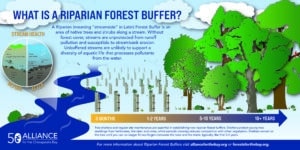PA Riparian Forest Buffer Project
Reforesting our streamsides
A Riparian (meaning “streamside” in Latin) Forest Buffer is an area of native trees and shrubs along a stream. Without forest cover, streams are unprotected from polluted runoff and runaway streambank erosion. Bare stream sides are unlikely to host aquatic life which filter pollution out of our water.
Clean water and healthy aquatic ecosystems need forested streams
Historically, we haven’t cherished our streamside woods as much as we should have. Many were cleared for development or agriculture. There are currently over 400,000 unforested riparian acres in the Pennsylvania portion of the Chesapeake Bay Watershed alone.
Our mission is to reforest as much of these riparian areas as we can by planting trees and shrubs, mostly on private land. This will not only dramatically help clean up our local streams and eventually the Chesapeake Bay itself, but will exponentially improve the properties where trees are planted. Livestock will be healthier, pollinators and other wildlife will return, and landowners will benefit from their new forests, which will only get better with time.
Forests also give us many other benefits, from providing habitat for pollinators and wildlife, to sequestering carbon, to providing perennial food sources like native fruits and nuts.
The Impact of Livestock
It is still very common in Pennsylvania for livestock to be pastured around streams, partly because those areas are not suitable for row cropping.
Cattle need water too, but they significantly harm aquatic life and water quality by increasing bank erosion and passing waste into streams. Livestock in streams are also at high risk of infections and fatal accidents.
Excluding them from the riparian zone and planting trees there instead is a win-win for all.
Our Riparian Forest Buffer Program
Any landowner, from private citizens to municipalities to churches and schools, is eligible for our riparian forest buffer program. We cover 100% of the costs of the trees and supplies required to establish the buffer. This includes invasive plant control, tree tubes and stakes, installation labor, and 3 years of post-planting maintenance.
We require a minimum average buffer width of 35 feet from the top of the streambank. This means that we can dip below 35 feet in tight spots if necessary, as long as the width is made up for in another section of the buffer. We can plant as far as 300 feet from the stream.
As of November 2024, we have planted 1054 acres of riparian forest buffer on 296 sites in Pennsylvania.
Contact Ryan Davis, Senior Forests Projects Manager, for more information.
